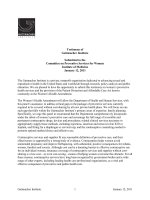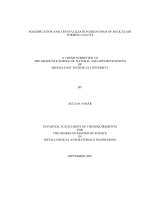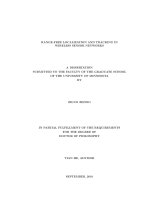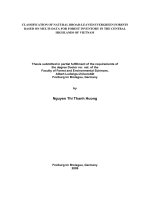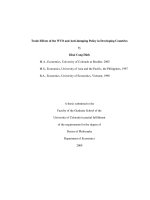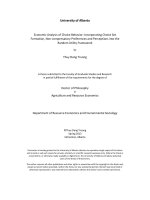¡. THESIS SUBMITTED TO THE FACUTTY OF GRADUATE STUDIES PARTIAT FULFILMENT OF T}iE RESUIREI\IENTS FOR THE DEGREE OF DOCTOR OF PHILOSOPHY
Bạn đang xem bản rút gọn của tài liệu. Xem và tải ngay bản đầy đủ của tài liệu tại đây (7.66 MB, 181 trang )
lHE UNIVERS]TY OF MANTTOBA
POPU],ATÏON PARANiETERS AND B]OENERGETIC
DEMANDS OF VIALLEYE,
Stizostedion vitreum vitreum. (Mitchill),
IN RETATION TO THEIR TROPHTC DYNAMIC ECOLOGY'
WEST BLUE
LAi{E,
MANITOBA
by
JOHN
R.M.
¡.
KELSO
THESIS
SUBMITTED TO THE FACUTTY OF GRADUATE STUDIES
IN PARTIAT FULFILMENT OF T}iE RESUIREI\IENTS FOR THE
DEGREE
OF DOCTOR OF PHILOSOPHY
DEPARTIV]ENT
OF
ZOOLOGY
WINNIPEG, MANITOBA
FAT,L
,
Tg?I
O
i
i,,ih i!
ilì0
tJA
o\
ko" DÅFtËj#S
TAB],8 OF
CONTENTS
Page No.
Introduction
1
Methods and Materials
3
Vital Statistics of the Population
Capture and Handling
Mortality Trials
3
3
6
6
8
9
Estimation of "Abundance
Natural MortalitY
Grov¡th
Biomass and Production
10
I,aboratory Food Studj-es
Gapture and TransPort
Holding Conditions
11
11
Natural Feeding
L5
Calorimetry
L7
l2
L2
Exper'imental Treatment
Terminology and
Statistical Analysis
18
2I
Results
Vital Statistics of the Population
Mortality Trials
Background to lvlark and Release Exp'ts.
Àbtindance Esti-nates
2L
2L
23
29
Natural MortalitY
34
Biomass and Produetion Estimates
49
Laboratory Studies
Effect- of Ration Size on Conversion
Conversion EfficiencY
52
54
5?
66
7o
7?
Growth
36
Maintenance Requirements
Availab1e Ration
An Unaccounted
for
EnergY Excess
Natural Feeding
Caloric Condent of Walleye and Their
Natu,ra1 \^Ial1e.ve Feeding
Population ConsumPtion
Food
79
79
B6
93
Discussion
Vital Statístics of the Popula.tion '
Abu.ndance Estima-tes
Natural I'{ortality
Growth
Biomass and Prod.uction
T,aboratory Studies
Natural Feed.ing
Population Consumption
98
98
98
LOs
LO7
110
113
L??
J-32
Summary
L36
References
r39
Appendix
L]ST OF TABLES
Page No.
Table I.
Numbers
of vralleye captured, relea.sed,
to June l9?O
marked, and recaptured from \¡\ay L969
in West Blue lake,
22
Table II.
Effects of hand.ling and marking on walleye
survival
Table III.
Results of chi-square tests of the hypothesis
that rates of recapture for fish age II to VI were simj-lar
between adjacent capture periods and for the entire 1969f0 period.
Table IV. Estimates of l¡/est Blue Lake walleye abundance
excluding (Xf) and including recruitment (WZ), standard
deviations indieated in parenthesis.
Table V. Estimates of West Blue lake wall eye population
*
characteristics u.sing Jotly' s Oge 5) pro,c'edú.re, SymboJ-s
in parenthesis ai column heads are those used. throughou.t
this study. Figures in parenthesis are standard.
deviations.
Tab1e VI. Survival and instantaneous mortality rates
of walleye in trVest BIue Lake ,
Table VII. Population characteristics of lVest Blue Lake
walleye derived from a triple-ca-tch-tre11is analysis
procedure du.ring periods of constant recruitment (May
to September, 1969, and September L969 to May 1970).
Figures i-n parenthesis are standard deviations.
Table VIII, Results of paired- "t" tests appl-i-ed to
growth measLr.res for the period between lr'iay and- June
L969. NS mea.ns not sígnificant.
Table IX. Lengths (mm) at annulu.s forrnation of walleye
in West Blue T,ake, 1969-70. N represents the number in
each sample.
24
26
30
32
33
35
¿tl
45
Table X. Rela.tive grorvth in length anci vreight (h¡ and
hç,respectivel¡r) from previous annulí, and instantalleous
rates of growth in length and weight (gl and gG respec-
tively) for vra.I1eye, 1969-?O ,
Table XI. Percentage of annu.al growth in v¡aIleye by
comparíson to size in May and to increment from adjacent
annuli (in parenthesis).
Table XII. Estimates of biomass (E) and produ.ction (P)
in rrVest Blue Lake u.sing the arithmetic approaeh v¡ith
averà$e'lveight (w) for each age group and instantaneotls
grovrth in weight (g). Estimates of N in parenthesis
are recruited population,
4Z
48
50
Table XIII. Effect of ration size (% body weight) on
conversion (K1 and K2) for walleye at L6C.
Table XIV. Changes in energy content of whole a.ge II+
walleye before and after growth determinati-ons (standard
deviations are in parenthesis).
Table XV. Conversion efficieneies (standard deviations
are in parenthesis) of age II+ walleye for experiments
at different temperatures.
55
6o
63
Maj-ntenance requirements expressed as ng/g/wk
68
V, and VI year old walleye at LZC.
Table XVII. Experimental and derived (equations for cray-.
fish and emerald shiners derived by procedures in the text)
relations between assimilation efficiency (E) and walleye
weight (vi) for various natu.râl food organisms.
76
Table XVIII. Energy utilization by walleye for maintenance, routine metabóIism (fn) and tfre excess in energy ( T)
above twice the routine level (r-Ztn). All measures are in
calorj-es and figures in parenthesis are standard
deviations.
?B
Table XVI.
of II,
TV,
Table XIX. CaLs/g weight, moisture, and ash content of
erayfish (0, virilis) collected in West Blu.e Lake, L969-
ievlati-ons are in parenthesis.
Table XX. Calories/gram, ash, and moisture of age 0
perch, Sergg flavessens (mitctritf ), and older fish
õollecteã--TFom West BLue T,ake , I97o. Fi-gures in
parenthesis are standard deviations.
Table XXI. Energy content (cals/g), percent moisture,
and ash of common lvalleye diet items, West Blue T,ake,
L9?O. Stand.arcl deviatións are Í-n parenthesi-s,
Table XXII. Surnmary of wal] eye f eeding during the icefree period, L9?O,
Table XXIII. Contribution of the diet items found in
walleye stomach to walleye nutrition, West Blue Lake,
Lg7O,
Table XXIV. Biocontent and energy production at a hypothetieal temperatu.re (column 4) for vralleye in West Blue
Lake. Intake (n) for the period and daily ratj-ons v{ere
to natu.ral
calculated using derived conversj-on adapted
situati-on.
?O,
Standãid
B0
Bz
84
B?
9L
9l+
IIST
OF FIGURES
Page No.
Fig.-1. lfgst BIue Lake shovring location of gill
netting sites.
Fig. 2., T,ength frequency distributions of waI1e¡re
captured by J.81, 6.35 and 8.8! cm giII nets in t¡/est
Blue T,ake , L969-7O. N represents number captu.red in
each mesh,
Fig. 3. Length frequ-ency dístributions of walleye in
West Blue Lake captured during mark and release periods.
Lt
28
3?
Fig. 4. Length increments (¿1,) of West Blue Ï,ake walleye
during the growth year (from last week of June to one
year later).
39
Fig. 5, The relation between weight (tg) and total
42
leñgtñ (mm) for West BIue T,ake walleye (Glenn, MS 1969)
Fig. 6, Cunulative growth in walleye (¿c) in grams wet
weight during the growth year, L969-70, in West Blue Lake blr
Fig. ?. Effect of ra.tion size on conversion (K1) at 16c
for walleye fed on emerald shiners.
56
Fíg. B. Accumulation of weight (S) by walleye fed at l+%
boãy weight at 2O, L6, and 16-BC.
58
Fig. 9. Effect of experiment du-ration on K1 for vralleye
net¿ at 20, L6, and 16-BC. All fish were fed a.t a ration
6t
of 4/" body weight.
Fig. 10. Conversion efficiencies in three orders (Kt,
6t+
K?, and K3) as affected by size of experimental walleye.
Fig. 11. Relationship between maintenance requirements
(cãtoric values in paienthesis) and temperatu.re for
walleye.
Fig. 12, Effect of ration size (in calories ingested)
on-the assimilation of age 0 perch by walleye If+ (upper)
and old.er (lower) at I6c.
Fig. 13, Effect of fish size (g wet weight) on assirnilation efficiencies for walleye fed at 16C.
Fig. 14. Change in energy content of walleye du.ring I97O
in West Blue Lake.
Fie. 15, Contribu.tion of all diet items in terms of
welght-(----) and calories (-) in relation to body siàe
of vìa1]eye in West Blue Lake, during the ice-free period,
69
73
75
B5
L970,
BB
Fig. 16, Contribution, by taxon, of resident organisms
to the diet of walleye in lVest Blue Lake , ]-970,
9o
ACKNOV¡LËDGEMENTS
The kind help and guidance
of Dr. F.J.
I¡/ard
financíal support of the Manitoba Provincial
Government made this investigation possible. Dr. T,;J.
Johnson's aid in establishing priorities in the laboratory was most helpfut. The remaj-ning committee members,
Drs. K, Doan and R, Green, also provided advice and
'guidance. The help of graduate students in the field,
and my wife in the laboratory was critical to this stud.y.
and the
ABSTRACT
During 1969-ZO, 569 walleye age II and older were
marked in West Blue Lake of which J6 were recaptured. No
short term mortality was found in conjunction with mark and
release periods. As well, distribution of marked fish was
essentially random, and sirnilar segments (by age) of the
population v¡ere undm examination at all times. Frequency
distributions a.nd *
tests ind.icate that net selection
was not by age and unlikely to be by size. The May 1969
population, 1090 walleye, decreased to 819 individuals in
May 19?0, but was augmented by 2100 Rew recruits in September,
1969, Petersen estimates, the Jolly (irg65) approach, and
the triple-catch trellis provid.ed similar descriptions of
the population. Mortality on a per day basi-s was small,
mean i = 0.0045, and was greatest ,during faIl and winter.
.Growth, and consequently production, was greatest between
kg, was
stable from year to year, and. production, l4O kg, was
primarily from younger fish.
June and September. Biomass, approxima.tely 800
conversion; K1 (##) and K2 (uffi), was affected
by neither ration size nor temperature, but decreased with
(#hUT) was affected
only by temperature. Walleye assirnilation efficiency was
d.ependent upon diet type (1east efficient for invertebrates,
and most efficient for fish), and. fish size. Maintenance
per unit walleye was independent of size but was affected
increasing fish size ,
K3 conversion
by tempe.rature. Maintenance requirements, all converted
to zoc for various agg walleye approxirnates vlinberg's
J
(Lg56) T = J w' for routine metabolisrn.
¡, séasonal cycle in caloric content of whole walleye
(Iess,.gonads) occurred and was also evident in perch. No
in invertebrates examined.
Greatest energy eontribution to the nutrition of
West Blue Lake wâI1eye was by pereh and stieklebacks. Greatest numêrÍöaI contribution was by amphipods 4nd nayflies but
both provided less energy.
such cycle was apparient
Laboratory conversion and assimilation efficiency
was applied to the natural diet of walleye for an estimation
of population intake. The resident population required from
40 to 1860 K ca¡/kg/day for production, and the intake depended
upon season and population structure.
t
INTRODUCT]ON
Investigations into quantitative relationships
of fish and their food follow three general approaches:
defining biomass of food and fish; determining turnover in
inorganic materials, such as nitrogen; and establishing
energy transformations. Allan 0.95]-).and Johnson Ogee)
utilized
maintenance requirements and gross conversion in
the defi.nition of population requi-rements. In addition
Gerking (1-962) ¡ras described the turnover of nitrogen in
the bluegill sunfish. Mann (1965) tocated the enerîgy transfor:matiorr in a river using procedures originally pointed out
by winberg (L956),
of this study were twofold: .a) to
determíne chara.cteristics of growth, number, survi-val and
ultimately biomass and production of an unexploj.ted population
of walleye, Stizostedion v. vitreum (wlite¡rifl), and b) to
describe under controlled conditions the effect of temperature,
ration, and walleye size on growth, rnaj-ntenance, and assimilation. The latter aspect of this investigation was based on
theoretical reviews of growth anrl metabolism (paloheimo and
Dicki.e , ]1965, 1966a and b). The stated otrjectives were
fundamental eomponents in .understanding production processes
in natural systems and were consequently extended to describe
seasonal differences in intake requíred to produce observed
produeti.on in an unexpl-oited population.
This study util-ized the calorie to describe two
The objec'cives
2
primary facetsr production and laboratory studies¡ of the
research. All parameters of this closed population were
defined in t969-?o to provide a basis for estimatíng seasonal
energy requirements. Laboratory experS-ments and analysis of
natural feeding were condueted after the population studies
to eliminate externar influences on the population.
of an investigation into energy transformation in a population inherently results ín difficulties
both in field and laboratory anal-ysis. Generalization to
natural systems upon the basis of controlfed experiments is
difficult in spite of the conducted experiments which were
desig4ed to show the role of specific mechanisms knov¡n to
j-nfluence grolvth. Nevertheless, the definition of population
changes and energy input is worthv¡hiLe both in terms of the
trophie dynamic ,ecology of the waì.leye ín !,iest Blue lake,,and
!
in terms of fishery management practices.
The scope
'
'3
I'¡ETH0DS AND M¡.TERIÀLS
west Blue T,ake (latitude s]-o 36', longitude 1o0o
55,) is located. central-Iy in the Duck Mountain Provincial
Park of west-central Manitoba. The take (f6O ha. ), described
by Bell and Ward (tg?O) , is essenti-al}y a closed system with
no permanent inlet or outlet, The characteristics of stratifieation in oxygen and temperature (geff and Ward, ibid)
rel-ativel¡t static from yea,r to year and are subject to rather
minor changes in nagnitude.
Throughout the course of this investigation
authoritie$ prohibited all but experimental
fishing in the lake; therefore' the population demonstrates
primarily indueed changes of natural causes.
provincS-a1
VITAT SÎATISTICS OF THE
POPULATION
Capture and Handling
Fish utilized throughout this stud.y were captured
in a standard gang composed of three sections each 30,5 m
1-ong and 1.8 m deep. Mesh sizes were 3'Bl , 6'35' and 8'89
crn, stretched measure.
.Asthemeandepthofthelakeisllm''andthe
basins have steeply sloping sides, the sites for capture
are linited (FiS. 1). A sta.ndard gang was set at one of
the possible sites approximately J0 minutes prior to sunset
L+
FiS. 1. West BIue Lake showing location of gil1
netting sites.
q
ù
{
:
1 KI..CI,|ETER
5
of water. Nets hatl been installed in 3-25 m of
water on bottom and. mid=water d.uring all times of day¡
however, all eaptures were limited to dark hours and occurred
ln watêr Less than 15 n in depth. Duration of noeturnal
fishing depended upon the catch and environmental conditions.
After installation, nets were continuously patrolled by boat
and captured fish y{ere either placed immediately in a "live
box", or transported to it after storage for 3 to 5 minutes
in 25O I of water maintained at air saturation with oxygen.
No entangled f i-sh remained in the net longer than 10 minutes,,.
Fishing time ín each basin was approximateiy equal for any
in 3-I5
m
narking râñd release period
fish were retained overnight in a live box
constructed from a plastic boat (length 2,55 mi width L,22 mi
mean depth 0.38 m) drilled with holes Áo that it could be
al-most fiIled with water. In June, this ,live box was subdivided to facilitate the separation of each night's eatch
by mesh size, A maximum of ll0 walleye were retained in the
live box from each night of sarnpling. The live box was
anchored approximately 30 n offshore to permit ventilation
Captured
by surface currents
The following morning, after fish were examined
for ilI-effects of handlingl the total length (from tip of
the snout to the farthest projection of compressed lobes of
the caudal fin) and fork length (from tip of the snout to
angle between Lobes of caudal fin) were obtained for each
fish. In addition, a seale sample was taken,using a forceps,
from the left side just above the lateral line on a diagonal
between
the posterior insertion of the second dorsal and the
6
anterior insertion of the. anal fin. Fish were then
with an injector type tagging gun (Oeft, 1968).
marked
Mortality Trials
In conjunction with each marking and release experiment (except during May 1969) a mortarity trial was conducted
on sho're. Eight or twelve f ish were held in two lots of equal_
numbers of narked. and unmarked individuals in 560 I fibreglass
tanks. Walleye utilized in holding triaLs were approximately
paired,in terns of length. One member of each pair was
subjected. to procedures identical to those applied to fish
invol-ved in the regr:lar periods of marking and release. The
other member of the paÍr was transferred to the holding tanks
with a minimum of handling. Water was supplied by pumps with
lntakes installed 1.J m below the surface of the lake and
provided. a tank turnover time of t+5 minutes, Experiment:.
duration was seven to twenty-seven days. No food was supplied
during holdíng. Temperatures in eaeh tank were record.ed. daily
with Taylor maximum and minimum registering thermometers.
Dissolved Oxygen, d.etermined. using the Azide rnodification of
the Winkler method, was determined several times at irregular
intervals during the holding periods.
Estination of Abundance
Six mark and recapture experiments were carried out
during 1969-ZO (taUte I). Tt was originall-y intended that
several teehniques for the assessment of population characteristics be employed; however, only a lirnited approach was feasible.
Populatíon abundanee at six tines during 1969-?0
was estimated by the Petersen teehnique (see Ricker, l95B),
originally intended to be based on samples
of 100 fish, captured during each of the six sampling periods...
In West Blue T,ake, the new recruits appearing in the population
are readily recognizable by their size and were marked and
released as a separate cohort in September Lg6g (faUte I).
Any analysis of canímal populations involving mark and recapture
is affected by various assumptions (Rieker, L958); therefore,
as many assumptlons as possible were investigated. One
requirement of abundance estimates in that an equal (or
measurable) rnortality oceurs within marked and unmarked
populations. If this stipulation is val1d, captures and
reeaptures subsequent to initial marking can be summed
Since short-term holding trials indicáted no mortality, I
chose to base each estimate on adjaeent capture periods, thus
eliminating the possibility of long-term mortality. Remaining
assumptions affecting population estimates, defined in terms
of applicabílity to this study, are -presented 1ater.
Because of the ease of separation of new recruj-ts,
Each estimate was
from the May 1969 population, the population can be monitored.
in terms of total number (aIl fish, including new reeruits)
and original number. Throughout this investigation the
as being those frsh of
population was generally
"orrsidered
total Iêngth greater than 25 cÍÌ.
The observed population was stratified further
into age groups by locating proportions of each age group
in the catch and apportioning ^N accordingly.
Marks and
I
recaptu¡es for each age were too smal1 to permit sepa.rate
popula.tion estimatesfor each age.
Natural Morta.lity
.
Survival rates ean be derived from comparison of
recaptures to the marks released by the following procedure:
M2 (nrl)
t"L? _- MI-TRãtr
where
êfZ = survival late between times
landz
MI = marks released at time 1
InZ = marks released at time 2
Rl3 = recaptures frorn lllt at time 3
RZl' = recaPtures from M2
at tine
3
rn this j-nstance, mortality is a result of natural causes;
therefore, since s = (r - a) where i = totar instantaneou.s
mortality for that period
i = -log"s
is identical to that of Ricker (fgSS)
however, esti-mation of t12 is an a.daptation of Ricker,s
equation 5.2, In this case, the recaptures are in a point
of time rather than oceurring over an extended period..
Statistical limits for all estimates are those described by
Ricker (1958). Since recaptures for any age group were
relatively small, survival consequently rnorta.lity - applies
to the whole populatÍ-on.
In addition to population estimates obtained using
the Petersen procedure, I calculated estimates of N, s, and
r (recruitment) by procedures outlined by JolJ-y (196Ð, As
well, for per:iods of approximately constant recruj-tment and
mortality, the triple-catch trellis (Ricker, 1958), was used
to obtain estimates'of walteye abundance.
Symbolism here
9
Growth
either
Estimates of seasonal growlh can be determined by
d j-riect or indireet approaches. Since only lengths
were obtained from any sample
of wa.Ileye, length increments
direct approach availa-b1e.
To define growth by the indirect method, several
scales from one fish were mounted on an acetate slide and
inpressions made using a roller press. Mounted scale impressions were ther¡ examined using a Bausch & T,omb projector
(magnification of I+3,5X, deterrnined by a calibrated stage
micrometer). For each fish, the anter.ior scale radius from
the focus, and the distance of each annulus from the focus
was recorded. Each sl-id.e v¡as examined twice and disagreement
resulted in further reading. A linear regression equ.ation
was found suitable for describing the relationship between
scale radius and fork length.
Annulus formation in most. West BIue Lake walleye
oeeu.rs during the last week in June (Glenn, MS 1969) t therefore the grorving season was considered as being the period
from the end of June y969 to the end of June A9?0. Fish
captu.red during this period were utilized to assess sea-sonal
growth. The increment from annulus to time of capture was
provid.ed the only
determined. as follows
!
1) An estinated scale radius from focus to the scale
periphery vras determined for each fish by using its fork
Iength in the scale radius-fork length linear equation.
Z) This theoretical clistance .v¡as then compared to the
actual measured ciistance to proúide a correction term for
all measurements for that particular individual (nite, 191+l).
10
distance ¿T, was determined by subtracting the
distance of the focus to the,periphery from the distance
of the focus to the outside annulus..
l+.) The d.istanee. b.etwe.e,n eac.h annrrli was loeated using
3)
The
the above procedure.
5) Weight at time of capture and last annuLus was found
using 1og W = -5.463 + 3,16J 1og I, where w = weight and
I, = total length (clenn, lts L96g).
6) The difference,ÁG, v/as obtained by subtraction.
Relati-ve growth rates were calculated using:
:
Sr
h____
i
i
i
S'r
where h is the relative growth rate, and S, j-n terrns of
length or weight, refers to size at tines one and two.
Relative rates were transformed. to instantaneous rates (g)
expressed. on a daily basis (g = loge (n+f¡ ¡.
Biomass and Production
'
Bionrass changes
in a stock are
dependent upon the
initial biomass (81) and instantaneous rates of growth (g)
and mortality (i). Therefore, average biomass of the stock
(E), defined as all members of the population 2J cm or greater
in total length, was determined by!
(e>i)
5=Br(es-l-r)
g-1
or5=W
-
Ii
-rr) \
'.
(e¿ i)
In addition to describing E' by using instantaneous rates, the average biomass v{as found by using the
::].:+i
11
arithmetic
mean
of two ad.j.acent estilnates of biomass, i.'e
Br + Bl
-!rr-! - -
#aSestimates1¡¡eremadewithinashortinterval
(Chapnan, 1968). In this case, results obtained by both
techniques wer.e only slightly different; therefo¡e, the
Iatter, more straightforward approach was utilized in
describlng the populati.on energy demands.
Às well, production (total- proliferation of fish
flesh including those that do not survive to end of ¿ t) was
caleulated for each time period using P = g E.
LA.BORÀTORT FOOD STUDIES
Capture and TransPort
Thirty-three walleye, 1g" II to VI, were captured
in a standard gang during the period between May 22 and 26,
Lg?O,,stored^ in the 560 1 tanks on the ]a-keshore, and trans:
ported to the Department of Zoology, Universíty of Manitoba
on May 26, lg?O. Transportation took 4.J hours fron the
field station to the university. .[nesthetized fish (¡ttszzz
at ?5, OOO ppm) were transported in two plastic tanks of 455
and 2?O L capacity. Water was maintained between 6 and Bô
by ice, and oxygen was kept at air satura.tj.on using an aerator
oper:ati-ng on a 12v wet cell batter¡r' Fish were upright and
mobile, but quiescent. 0n agival, all fish were placed in
one 2?30 I fibreglass tank and held at BC.
L2
Holding Conditions
for the aquatic holding facilities
utilizes the domestic supply of the city of Winnipeg. Incolning
water is p,assed through actiyated charcoal filters to remove
chlorine. Dechlorinated water is available from three lines
at 3,3, L!,? and, 26,7C, All plunbing for the system is PVc
(polyvinytchtoride). Àir saturation with oxygen is Loo%
(3,3 and 11.?C lines) and 85% (at ?6.?c). Alkalinity of alt
three supply lines is l-,2O ng/L and pH varies from 8.J to 8.9.
Temperature control ln holding tanks and all feeding
experiments was aehieved using a Power Series 440 Fotoguard
mixing valve. The rnixing valve was modi-fied so that all three
temperatures couÌd be united, yielding a wj-der temperature
range and higher oxygen saturati-on. Temperature adjustments
were made, if necessary, twice daily. All animals under experimental conditions were subjected to a diel cycle of 14 hours
light and 10 hours dark. À11 tanks, except when stated,
were 560 I fibreglass tanks covered by a translucent green
fibreglass cover..
To minimize the incidence of j-nfectj-ons, malachite
green, ât an initial coneentration of 150 ngn' r,vas adninistered. to wa,lleye soon after their amival at the Zoology
facilities. Residence time of the fungicide was approximately
I,J hours and rapid dilution occurred during this period.
The water system
Experimental'Treatment
Food used in all .experiments (excluding those to
estimate assimilation
)
was
a cyprinid, the emerald shiner,
I3
Itq+it atherinoides (Rafinesq.ue), captured by seining
at Delta Marsh on lake Manitoba on Ma.y 14 to 16, Lg?O,
Most of these minnows were frozen j-n sealed, sterile, prastic
whirt-Pak bags. The remainder were rnaintained live as food
for fish age rrr+ and order. Bimonthly samples of the frozen
food were analysed to define gross change in caroric eontent
during experimentation.
After holding for one week at BC, food in approxinately 1009 units was placed in the tank once daily. surplus
after one hour. This practice was continued
until most fish readily accepted the food. Fish were allotted
to the experimental tanks and acclimated to the new condi-tions.
fndividuals in an experimental group were closely rnatched, each
group having a narrow range in weight. Those individuals not
under experimental conditiotrs were kept at, J.ãC and fed at 3%
of body vreight per d.ay.
Individuals used to assess growth and maintenance
requirements were acclimated from B to LZC to the new temperature at the rate of I degree change per day. Each experimentar group was then subjec'ced to experimental conditions of
food and temperature for two weeks before an experiment was
considered sta.rted. Frozen emerald shiners were the staole
food for all rr+ fish under conditions to determine growth
and maintenance. -4. suitabre unit of food was partially thawed,
counted wherr amounts introduced were less than 2Og, and weighed
using a top loadi-ng bala.nce accurate to * 0.01g. Walleye
foocl was removed
- ---.-L
aged
III-
and older refused to accept dead food; therefore,
sj-ze compar:isons necessitated. using live emerald shiners of
14
content. Live weight was obtained by introducing
the rninnows into a tared 500 mI beaker containing aerated tank
water. All walleye were fed six days per week at the rate of
one food lot per day. Walleye were measured and weighed,
using the top loading balance, on the seventh day afte'r belng
arrestheti.aed.in a solution o.f ?5,AOO ppm MS222' and blotted
dry. The amount of food administered to those on maintenance
diet was adjusteQ daily until walleye attained a constant
'to 4 weeks, Overflow of all tanks
weight for a period o'f 3
$¡as screened by a double layer of nylon seine net to trap all
exeess food., Sereens were removed and cleaned daily. Tanks
were cl-eaned weekly as the turnover in the 560 1 tanks' onee
per 2J minutes, was insufficient to remove all excreta.
To assess assimilation of major natural ltems of
the diet, walleye were acclimated to 12 and zOC in 40 and ?2O
1- glass aquaria. T,arge food items (perch, Ferca flavescens,
fluviatelis; and erayfish, grcgnectis virilis.) were placed in
the phar¡mx and were voluntarily swallowed by all walleye.
Smaller organisns (Gammarus lacustris and emerald shiners)
were introduced into the stomach by a force-feeder consisting
of a p]-unger in a smooth Tygon plastic tube. All foods except
emerald shiners were obtained from Vfest Blue Lake. Initial
experiments defined the tirne between ingestion and egestion;
therefore, indiViduals were contj-nuously obs'erved at the time
of expected feces emission. Feces were collected within an
hour of emission using a large pipette, This concentrate of
water and feces was subsequently strained throu-gh a 53 micron
copper síeve. Feces were in the form of solid btreamers,
lmown energy
I
r5
plac.ed on the screen., remained suspended
in a large
bead of water. All collected feces were oven-dried at l05C
until a constant weight was reached. Dry weights were the
onlyi,feasible way of expressing the nagnitude.,of emission
s,ince r¡ralter uptake:, frçguently oecurred even during, the short
ti.me, before coll,ection. To test for eomplete collection of
feces, three tanks were cleared in the normal way and then
filtered through a Whatman No. 1 fj-lter. These filters were
then eo'mpaned to, filters through which a similar volume of
water, taken directly from the main water lines, has been
and.. when
passed.
NATURAT, FEEDING
\
A standard net was installed. at one of the sampling
sites (fig. f) Ì.J to 2 hours after sunset. Five separate
collections were made of walleye aged II+ and older. Captured
animals were,immed.iately removed from the net, placed in plastic
bags, and frozen at -25C for future determination of walleye
caioric eontent, and species number and weight of ingested
foods
The stomach was removed. while the walleye was
still
frozen. Thg excised gut was opened and all contents
were removed as a solid block. The gastro-intestinal tract
was then replaeed. a.nd the fish and its empty digestive tract
kept frozen until caloric analysis commenced. Material found
in the gut was thawed at room temperature, then sorted into
taxonomic groups and counted. Members of each taxa vrere
c.omplçtel¡r
..

